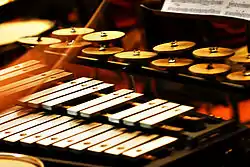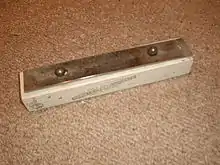Pitched percussion instrument
A pitched percussion instrument is a percussion instrument used to produce musical notes of one or more pitches, as opposed to an unpitched percussion instrument which is used to produce sounds of indefinite pitch.

A glockenspiel and a set of crotales in use

A chime bar in G
.jpg.webp)
A chromatic set of tuned cowbells
Pitching of percussion instruments is achieved through a variety of means.
- Membranophones are tuned by altering the surface tension of the face that is struck.
- Mallet percussion instruments gain their pitch through physical characteristics such as composition, density, or physical dimensions of each respective note.
- Alternatively, other percussion instruments can gain pitch through variation of air volume displaced.
The term pitched percussion is now preferred to the traditional term tuned percussion:
- Many untuned percussion instruments, such as the snare drum, are tuned by the player, but this tuning does not relate to a particular pitch.
- Untuned percussion instruments can and frequently do make sounds that could be used as pitched notes in an appropriate context.[1]
This second consideration also means that the traditional division into tuned and untuned percussion is to some extent oversimplified:
- Some percussion instruments, such as the timpani and glockenspiel, are almost always used as pitched percussion.
- Some percussion instruments, and particularly many types of bell and closely related instruments, are sometimes used as pitched percussion, and at other times as unpitched percussion.
- Some percussion instruments, such as the snare drum, are almost always used as unpitched percussion.
Pitched percussion includes the overlapping classes of:
- Mallet percussion, instruments such as the glockenspiel and chime bars, played in a particular way.
- Keyboard percussion, instruments such as the glockenspiel and tubular bells arranged in a particular way (but not including the celesta and other keyboard instruments despite the name).
- Melodic percussion, instruments used to produce several different pitches.
See also
This article is issued from Wikipedia. The text is licensed under Creative Commons - Attribution - Sharealike. Additional terms may apply for the media files.